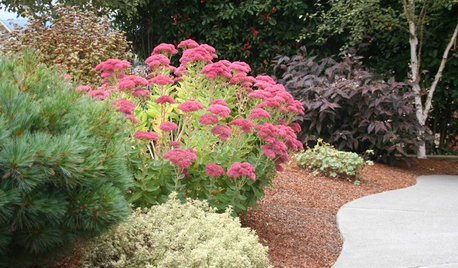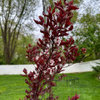Peaches splitting at the stem??!! (pics)
trfanatic
14 years ago
Related Stories

HOUZZ TOURSMy Houzz: Contemporary Split-Level in Chicago
An art-collecting Illinois family transforms their 1950s home, starting with a complete color redesign
Full Story
TREESGreat Design Plant: Coral Bark Japanese Maple, a Winter Standout
Go for garden gusto during the chilly season with the fiery red stems of this unusual Japanese maple
Full Story
GARDENING GUIDESPacific Northwest Gardener's August Checklist
Deadheading perennials, cutting raspberry canes and preparing for the onion harvest keeps Northwest gardeners busy in August
Full Story
HOUZZ TOURSMy Houzz: Midcentury Modern Style Transforms a Vineyard Bungalow
Spectacular surroundings and iconic design inspiration meet in a major overhaul of a 1960s Ontario home
Full Story
EDIBLE GARDENSHow to Grow Your Own Luscious Cherries
Nope, they’re not the easiest fruit to grow. But with spectacular blossoms and pies as possibilities, cherries are sure worth a try
Full Story
DECORATING GUIDESNo Neutral Ground? Why the Color Camps Are So Opinionated
Can't we all just get along when it comes to color versus neutrals?
Full Story
TROPICAL STYLEEasy Decorating: Turn Over a New, Tropical Leaf
Toss a palm frond in a vase or gather a whole bouquet — fresh or preserved tropical leaves bring on the exotic with almost no effort
Full Story
EDIBLE GARDENSSummer Crops: How to Grow Squash
Almost foolproof and with cheerful flowers, squash comes in a wide range of varieties to plant in spring
Full Story
GARDENING GUIDESHouzz Call: What’s Your Favorite Backyard Beauty?
The simple, honest daisy is this writer’s go-to garden flower. We want to hear which plant, flowering or otherwise, gives you special joy
Full Story
COLORSet the Mood: 5 Colors for a Calming Bedroom
Stressed? Can't sleep? Consider one of these cool, soothing hues for your walls
Full Story








alan haigh
olpea
Related Professionals
Forest Acres Landscape Architects & Landscape Designers · Elgin Landscape Contractors · Springfield Landscape Contractors · Alamo Landscape Contractors · Amesbury Landscape Contractors · Barrington Landscape Contractors · Commack Landscape Contractors · Cudahy Landscape Contractors · Davis Landscape Contractors · Gurnee Landscape Contractors · Lemont Landscape Contractors · Munster Landscape Contractors · Santa Ana Landscape Contractors · Stony Brook Landscape Contractors · Tehachapi Landscape Contractorsalan haigh
Michael
alan haigh
Scott F Smith
olpea
olpea
alan haigh
olpea
tcstoehr
trfanaticOriginal Author
olpea
alan haigh
alan haigh
glenn_russell
lauriedutch
trfanaticOriginal Author
jim123
alan haigh
glenn_russell
olpea
calliope